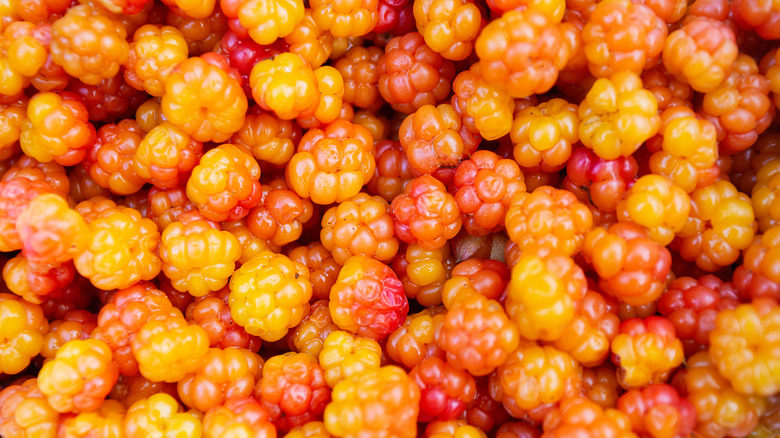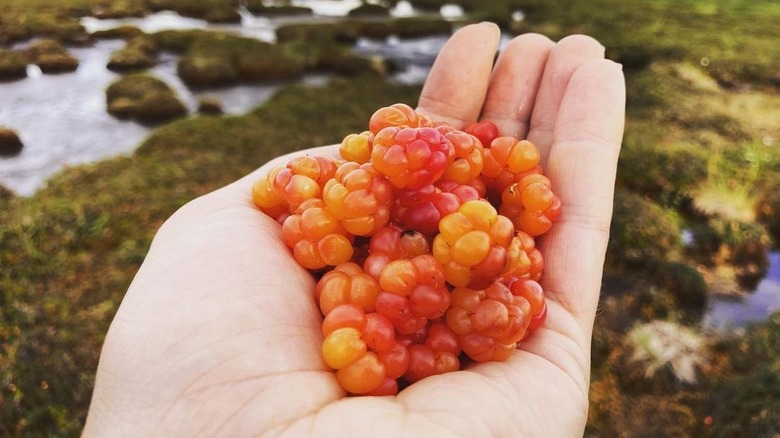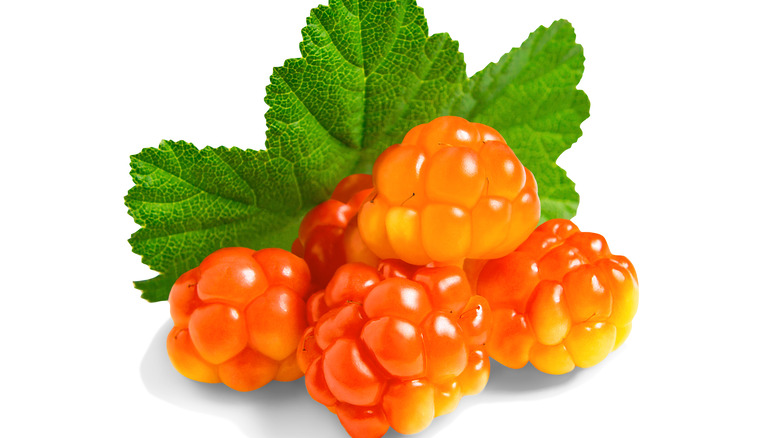What Is A Cloudberry And What Does It Taste Like?
The elusive cloudberry fruit is part of the Rosaceae classification, a family of perennial flowering plant species that also includes blackberries, cherries, almonds, ornamental roses, and apples among many others (via Encyclopedia.com). This small amber-colored fruit is similar in size to a raspberry and shaped like a blackberry with a similar tart taste. They are usually found in arctic regions where Eskimos have been known to collect them in the fall and store them for a food supply in the winter, according to Britannica.com.
Scandinavia is a big resource of these edible fruits as well where they are used for making desserts, preserves, and even a liqueur, adds the source. In fact, The Scandinavia Standard says they are often referred to as "Arctic Gold" because of their vibrant color and rarity. True to their name, they look like puffy clouds of golden goodness.
Here's a twist that makes the cloudberry even more intriguing — these berries are actually classified as a stone fruit, named as such because of the pit or "stone" in the center that is surrounded by the flesh of the fruit, according to All Recipes.
Where the cloudberry is grown and how to get some
The delectable cloudberry fruit can't normally be found in the produce department of your local grocery store like most other fruits, which only makes it more desirable. Cloudberries grow in cool temperate regions and are so rare that they are considered an endangered species in some countries, says Agricfarming. They are usually foraged and must be purchased from a specific resource like a very regional farmer's market or by going to a restaurant that uses them, says Farm Flavor.
This finicky fruit grows mostly throughout the northern hemisphere. In Europe, cloudberries can be found in northern Scandinavia, Sweden, Russia, Norway, Denmark, and Finland. According to Care Omnia, the colder areas of North America also produce cloudberries, such as Canada, Alaska, New Hampshire, Maine, and New York.
Cloudberries grow predominantly in the wild, and despite the high demand for this delicacy, they are not widely cultivated. This is likely due to the fact that it is extremely difficult to grow cloudberries as they are very sensitive to weather and temperature — not to mention the fact that the fruit can withstand temps up to -40 degrees Fahrenheit but the plant itself cannot so a dominant frost in any season might now produce a lot of berries.
Care Omnia states that it takes about seven years to grow this plant from a seed, and as such, it just isn't very economical to cultivate them as they also don't produce large quantities. In the wild, they grow close to the ground similar to a strawberry plant and their short harvest season is July to mid-August, according to the Scandinavia Standard.
What does the cloudberry taste like?
When you see a cloudberry, you'll probably just want to pop that golden pillow of fruit right in your mouth. When you do, you can expect a unique combination of flavors that Cuisine Vault describes as both "sweet and sour" with a combination of raspberry and red currants.
According to Farm Flavor, this fruit yields a "tart and sweet" flavor with a texture similar to blackberries but less seedy. The article quotes Chef John Shields of Smyth Restaurant in Chicago, who uses the fruit in some of his recipes, and says, "Cloudberries are technically in the rose family and carry a distinct floral note. On their own, there are hints of raspberry, mango, apricot, and passionfruit. We find that extracting the nectar brings flavors of yeast, citrus and concentrated watermelon." Farm Flavor also notes that, once overripe, the cloudberry takes on a creamy texture not unlike yogurt.
This unique combination of tart, tangy, and floral flavors that come together in the cloudberry furthers its reputation as a unique fruit that have people wanting to try them.
The health benefits of cloudberries
According to many sources, the juicy cloudberry provides a wide range of vitamins and minerals and has a history of purported health benefits. As noted by Nutrition Advance, cloudberries are one of the best sources of vitamin C among all fruits. They are such a significant source of this vitamin, in fact, that they are mentioned in historical Latin texts from the 16th and 17th centuries as an effective food to prevent scurvy. Vitamin C is often regarded for its immune-boosting properties, and the high content found in cloudberries makes them a very healthful addition to any diet.
Cloudberries are also touted for being like a superfood that contains a wide range of polyphenols, which are plant compounds that may be helpful for digestion, warding off heart disease, boosting brain health and possibly even preventing type 2 diabetes and some cancer types (via Healthline).
In addition, Nutrition Advance also states that cloudberries are a good source of magnesium, which is a mineral that is essential for maintaining good health and can be difficult to find naturally in food sources.
Cooking with cloudberries
Whether you are foraging in the wild or find these rare fruit gems in a farmer's market in the northern hemisphere, getting your hands on cloudberries will make a rare treat for your taste buds.
Fine Dining Lovers recommends treating them like raspberries or blackberries and using in the same way to make desserts, jams, and sauces. You can also substitute traditional berries with this golden treat in shortcakes or fruit pies.
Cloudberries are very juicy fruits and lend themselves to a traditional sweet liqueur popular in Finland called Lakka, says The Manual. This liqueur is very aromatic and bittersweet, making it a unique addition to a good number of craft cocktails.
If you are looking to save these sweet and tart treats for future use once you get your hands on them, Farm Flavor says they freeze well for up to two years. However, if you can find the cloudberry, the most highly recommended way of enjoying it is to eat it fresh right then and there and savor every bite.




